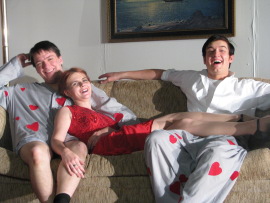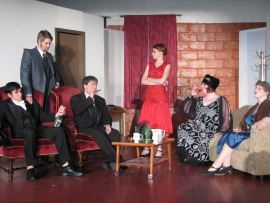 Design for Living, which Scott Community College is currently presenting at the Village Theatre, is a quick-witted Noël Coward comedy concerning an interior decorator (Bri Kenney's Gilda) who finds her romantic affections torn between a struggling artist (Randy Langtimm's Otto), and a struggling playwright (J.W. Hertner's Leo). It is also, by a considerable margin, the most engaging of the three Scott productions I've seen since November, and while I'm not usually the type to bestow awards, I want to begin by praising three facets of Saturday's presentation that might easily stand as theatrical "bests" of 2008.
Design for Living, which Scott Community College is currently presenting at the Village Theatre, is a quick-witted Noël Coward comedy concerning an interior decorator (Bri Kenney's Gilda) who finds her romantic affections torn between a struggling artist (Randy Langtimm's Otto), and a struggling playwright (J.W. Hertner's Leo). It is also, by a considerable margin, the most engaging of the three Scott productions I've seen since November, and while I'm not usually the type to bestow awards, I want to begin by praising three facets of Saturday's presentation that might easily stand as theatrical "bests" of 2008.
· Best use of a natural set piece. Coward's play opens in a Parisian flat in 1933, where Bri is conversing with her art-dealer confidante, Ernest (Daniel Schaub). At one point, Ernest asks for more light in the room, and Bri goes to the curtains hanging on the back wall, opens them, opens the window shade, and - well, I'll be ... ! - actual, honest-to-goodness sunlight shines in though a window conveniently built into the rear of the Village Theatre's stage. This unexpected blend of theatrical life and real life made me want to applaud.
· Best accident that may not have been an accident. After Bri's first scene with Otto, with whom she's been having an affair, the artist leaves the stage, and Leo - who's been hiding in the bedroom - enters. On Saturday, Hertner got his suit jacket caught in the bedroom door as he closed it behind him, but instead of re-opening the door and releasing his jacket, he simply removed it, left it dangling from the door jamb, and continued the scene. The audience snickered at the presumed goof, yet I'm not sure it was a goof; later, when Otto re-enters and Leo is forced to reveal his affair with Bri, he does so in the subtlest way imaginable - by returning to the bedroom door and apologetically removing the jacket. ("Oh," says Otto. "I see.") If the trapped-coat moment was an accident, it was a brilliant accident. If it wasn't, then it was merely brilliant.
 · Best consumption of liquids. As Design for Living is a Noël Coward piece, you can bet your badinage there's going to be drinking. But in Act II, after Bri has left identical "Dear John" letters to her two suitors, the abandoned Leo and Otto decide to drown their sorrows in glasses of brandy. Then they have two more. And then two more. And when the bottle is empty, they move on to the sherry. All told, the actors down (I'm estimating) more than a liter's worth of faux booze in roughly five minutes, and do so without so much as a belch. Coward would've been proud.
· Best consumption of liquids. As Design for Living is a Noël Coward piece, you can bet your badinage there's going to be drinking. But in Act II, after Bri has left identical "Dear John" letters to her two suitors, the abandoned Leo and Otto decide to drown their sorrows in glasses of brandy. Then they have two more. And then two more. And when the bottle is empty, they move on to the sherry. All told, the actors down (I'm estimating) more than a liter's worth of faux booze in roughly five minutes, and do so without so much as a belch. Coward would've been proud.
I'm guessing he would've been proud of much of Design for Living, because beyond the aforementioned minor pleasures, Scott Community College's production offers a major one in its representation of the playwright's delightfully epigrammatic style. The work isn't without psychological complexity; Coward's piece, after all, offers a ménage a trois as a perfectly viable and, for these characters, even healthy romantic option. But in director Steve Flanigin's take on the material, the more thought-provoking elements are kept where they should be kept - as enjoyably eyebrow-raising subtext. (Interpret how you will the moment when Leo and Otto enter from the bedroom, with Otto wearing the top half of pajamas and Leo wearing the bottom half.)
 Instead, the focus is rightfully placed on Coward's genius at blending high and low comedy - Esther Clement is a hoot as a surly maid with an ever-present cigarette drooping from her lips - and witticisms that zip by almost faster than you can register them. Certainly, that's often the case here; several cast members, particularly Kinney and Hertner, spit out their British-accented remarks so hastily that catching them all would be a Herculean undertaking. (The show runs two hours and 40 minutes, but not because of any lapses in tempo.) Her speed, though, is the finest thing about the lovely Kinney's performance here - her funniest quips tend to detonate two seconds after she's uttered them - and the gifted Hertner is at his best when Leo's edgy discomfort shifts to manic apoplexy.
Instead, the focus is rightfully placed on Coward's genius at blending high and low comedy - Esther Clement is a hoot as a surly maid with an ever-present cigarette drooping from her lips - and witticisms that zip by almost faster than you can register them. Certainly, that's often the case here; several cast members, particularly Kinney and Hertner, spit out their British-accented remarks so hastily that catching them all would be a Herculean undertaking. (The show runs two hours and 40 minutes, but not because of any lapses in tempo.) Her speed, though, is the finest thing about the lovely Kinney's performance here - her funniest quips tend to detonate two seconds after she's uttered them - and the gifted Hertner is at his best when Leo's edgy discomfort shifts to manic apoplexy.
Among an enthusiastic ensemble that includes Sara Bolet, Stephanie Hamilton, and an impressively double-cast Chris Wadsager (who, without help from the program, I wouldn't have known was double-cast), the empathetic, committed Schaub provides both resigned acceptance and intimidating, volatile rage, and Langtimm, who appears to love acting, delivers a sequence of wounded heartbreak that is easily the finest work I've yet seen from him. He still offers expert comic timing - even though his busy facial expressions too often steal focus from Schaub in the play's final scene - but I was thrilled to watch Langtimm emerge as an equally dynamic dramatic presence, and would like to see his stab at more tragic roles down the road. Maybe Brick in Cat on a Hot Tin Roof - Lord knows, after Design for Living, the man can handle his (on-stage) liquor.
For information, call (563) 441-4339.










